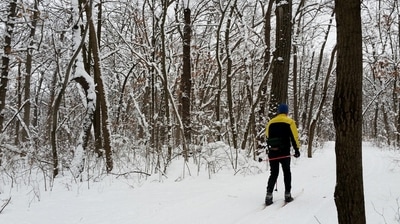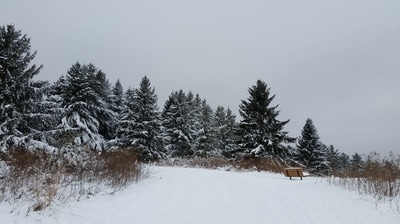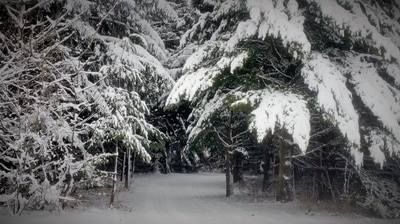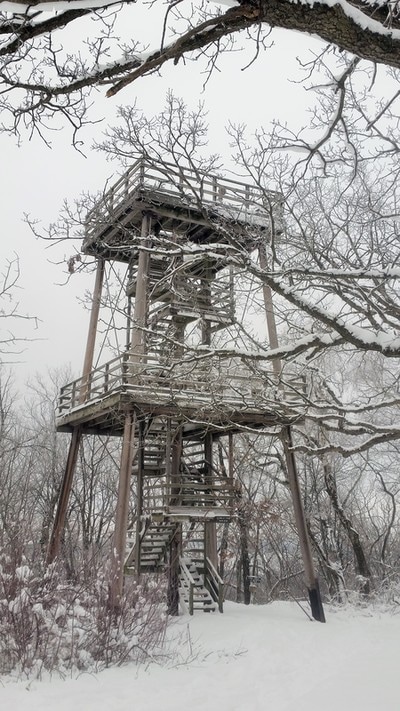Muffled, I say, because every tree from the fattest oak to the slenderest sapling had been slathered in a snow-spray that dampened sound across the 1,150-acre park. The snow still clung to the trunks and limbs three days after the storm. Spruce and pines on the hill-top ridges bowed under the weight.
The cross-country skiing was ideal on the newly groomed paths. We started early, with the parking lot nearly empty. Our skis made only a slight slicing sound. Our breaths came quick and light. A woodpecker throbbed in the distance.
At Blue Mound, ten miles of cross-country ski trails wind through forests of oak, maple, hickory, walnut, willow, and pine. Limestone boulders toppled from the mound litter the forest floor, mottled by green and brown lichen and striped with bands of white chert. The trails offer occasional heart-quickening downhills as antidotes to some long uphill climbs. A patch of prairie along the way bares the sky beyond the woods. Then, in the distance, the trail disappears again into the dark mouth of another stand of pine.
Due to alternating layers of limestone and shale, Blue Mound is awash in four-season springs. The pausing skier can listen to the gurgling of fresh water springs trickling through the snow.
Two observation towers at the crest of the mound offer wordless vistas taking in Madison 25 miles to the east and Baraboo 50 miles north.
Quiet pervades the woods, allowing the slightest of sounds to eke through.
* * *
Blue Mound looms silently in the southwest Wisconsin landscape. It takes its name from the atmospheric conditions of winter cloud and summer haze that give it a slight bluish hue visible for up to 50 miles.
The highest point in southern Wisconsin at 1,716 feet, Blue Mound is one in a series of tall knolls that dot the landscape in a general northeast to southwest line, including the Belmont Platteville, and Sinsinawa mounds in southwest Wisconsin, and Balltown and Sherrill mounds in northeast Iowa. The domes are remnants of a hard Niagara dolomite limestone surface bedrock that once sat atop successive layers of shale, sandstone, and older limestone in a slanted plane reaching 1,000 miles back to its namesake, Niagara Falls.
Although the landscape may be mute, it still manages to whisper its past. A “tree marker” on one of the trails is a centuries-old white oak shaped as a sapling by Native Americans to point toward the summer solstice sunrise. Burial mounds in the surrounding landscape harken back to an even more-distant human presence.
The first Euro-American settlers arrived in 1828, first to mine lead, then to farm. Although the park was not established until 1959, the mound gained an early reputation as a peaceful refuge. An 1870s Dane County guidebook said, “Persons desiring absolute quiet, pure air, and water cannot find a more suitable spot wherein to pitch their tent.”
But Blue Mound hasn’t always been so quiet. The Military Ridge Bicycle Trail that passes near the foot of Blue Mound is a faint echo of the 1881 railroad that once whistled through the nearby town of Mount Horeb. In the 1890s, visitors took the train to watch horse races at the top of the mound. The racetrack imprint is now an oval road at the top of the mound connecting the watchtowers.
Blue Mound continued as a bustling place for decades. In the 1940s and 50s it sported a ski hill on one of the mound slopes. Snowmobiles used the park up through the early 1980s. The machines were never banned as such, but eventually private sledding trails leading to the park were closed off by local landowners, and without enough trail routes within the park to make it worth the while, snowmobiling disappeared from Blue Mound altogether.
In recent decades, with over 20 miles of hiking, mountain biking, snowshoeing, and cross-country ski trails, Blue Mounds State Park has developed a reputation as a silent sports sanctuary across the seasons. Birders come for a glimpse of the 75 nesting bird species or the 150 species that migrate through spring and fall. Hunting is restricted to tracking the annual succession of spring, summer, and fall wildflowers.
It remains to be seen—or heard—whether the silent sanctuary will survive the return of snowmobile trails to the park in the near future. Opposed by the Friends of Blue Mounds who raised over $500,000 for the park in recent years, but supported by snowmobile enthusiasts who lamented a lack of public snowmobiling opportunities in the Madison vicinity, the reintroduction of snowmobile trails was recently approved by the Wisconsin Natural Resources Board after the decades-long hiatus.
* * *
After two and a half hours of cross-country skiing, Dianne and I were surprised to find the parking lot had filled as we completed our loop by noon-time. We had not noticed an influx skiers on the trail as the morning had worn on.
And there was still a hush over Blue Mound. -- February 2017



